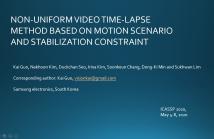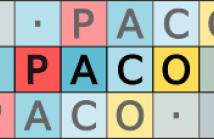
- Read more about EXPOSURE INTERPOLATION VIA HYBRID LEARNING
- Log in to post comments
- Categories:
 32 Views
32 Views
- Read more about MANet: Multi-Scale Aggregated Network For Light Field Depth Estimation
- Log in to post comments
- Categories:
 26 Views
26 Views
- Read more about Blind Multi-Spectral Image Pan-Sharpening
- Log in to post comments
We address the problem of sharpening low spatial-resolution multi-spectral (MS) images with their associated misaligned high spatial-resolution panchromatic (PAN) image, based on priors on the spatial blur kernel and on the cross-channel relationship. In particular, we formulate the blind pan-sharpening problem within a multi-convex optimization framework using total generalized variation for the blur kernel and local Laplacian prior for the cross-channel relationship.
- Categories:
 42 Views
42 Views
Tele-wide camera system with different Field of View (FoV) lenses becomes very popular in recent mobile devices. Usually it is difficult to obtain full-FoV depth based on traditional stereo-matching methods. Pure Deep Neural Network (DNN) based depth estimation methods can obtain full-FoV depth, but have low robustness for scenarios which are not covered by training dataset.
- Categories:
 42 Views
42 Views
- Read more about NON-UNIFORM VIDEO TIME-LAPSE METHOD BASED ON MOTION SCENARIO AND STABILIZATION CONSTRAINT
- Log in to post comments
Time-lapse of user captured video becomes popular in many applications recently, non-uniform sampling and digital video stabilization (VS) are usually two independent steps to keep meaningful contents and provide stabilized output. However, non-uniform sampling may produce large sampling interval and then result in larger motion, this would beyond the stabilization ability of VS and produce unpleasant output.
- Categories:
 16 Views
16 Views
- Read more about LEARNING GEOMETRIC FEATURES WITH DUAL-STREAM CNN FOR 3D ACTION RECOGNITION
- 1 comment
- Log in to post comments
Recently, regarding several beneficial properties of depth camera, numerous 3D action recognition frameworks have studied high-level features by exploiting deep learning techniques, but nevertheless they cannot seize the meaningful characteristics of static human pose and dynamic action motion of a whole action. This paper introduces a deep network configured by two parallel streams of convolutional stacks for fully learning the deep intra-frame joint associations and inter-frame joint correlations, wherein the structure of each stream is learned from Inception-v3.
- Categories:
 62 Views
62 Views
- Read more about PACO and PCO-DCT: Patch Consensus and Its Application To Inpainting
- Log in to post comments
Many signal processing methods break the target signal into overlapping patches, process them separately, and then stitch them back to produce an output. How to merge the resulting patches at the overlaps is central to such methods. We propose a novel framework for this type of problem based on the idea that estimated patches should coincide at the overlaps (consensus), and develop an algorithm for solving the general problem. In particular, an efficient method for projecting patches onto the consensus constraint is presented.
- Categories:
 20 Views
20 Views
- Categories:
 13 Views
13 Views
- Read more about Multi-Task Learning in Autonomous Driving Scenarios Via Adaptive Feature Refinement Networks
- Log in to post comments
Many deep learning applications benefit from multi-task learning with several related objectives. In autonomous driving scenarios, being able to accurately infer motion and spatial information is essential for scene understanding. In this paper, we combine an adaptive feature refinement module and a unified framework for joint learning of optical flow, depth and camera pose estimation in an unsupervised manner.
- Categories:
 10 Views
10 Views
- Read more about Unsupervised Domain Adaptation for Semantic Segmentation with Symmetric Adaptation Consistency
- Log in to post comments
Unsupervised domain adaptation, which leverages label information from other domains to solve tasks on a domain without any labels, can alleviate the problem of the scarcity of labels and expensive labeling costs faced by supervised semantic segmentation. In this paper, we utilize adversarial learning and semi-supervised learning simultaneously to solve the task of unsupervised domain adaptation in semantic segmentation.
ICASSP.pdf
- Categories:
 31 Views
31 Views